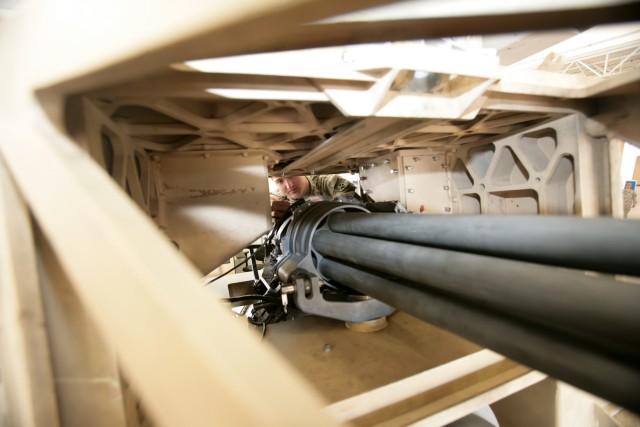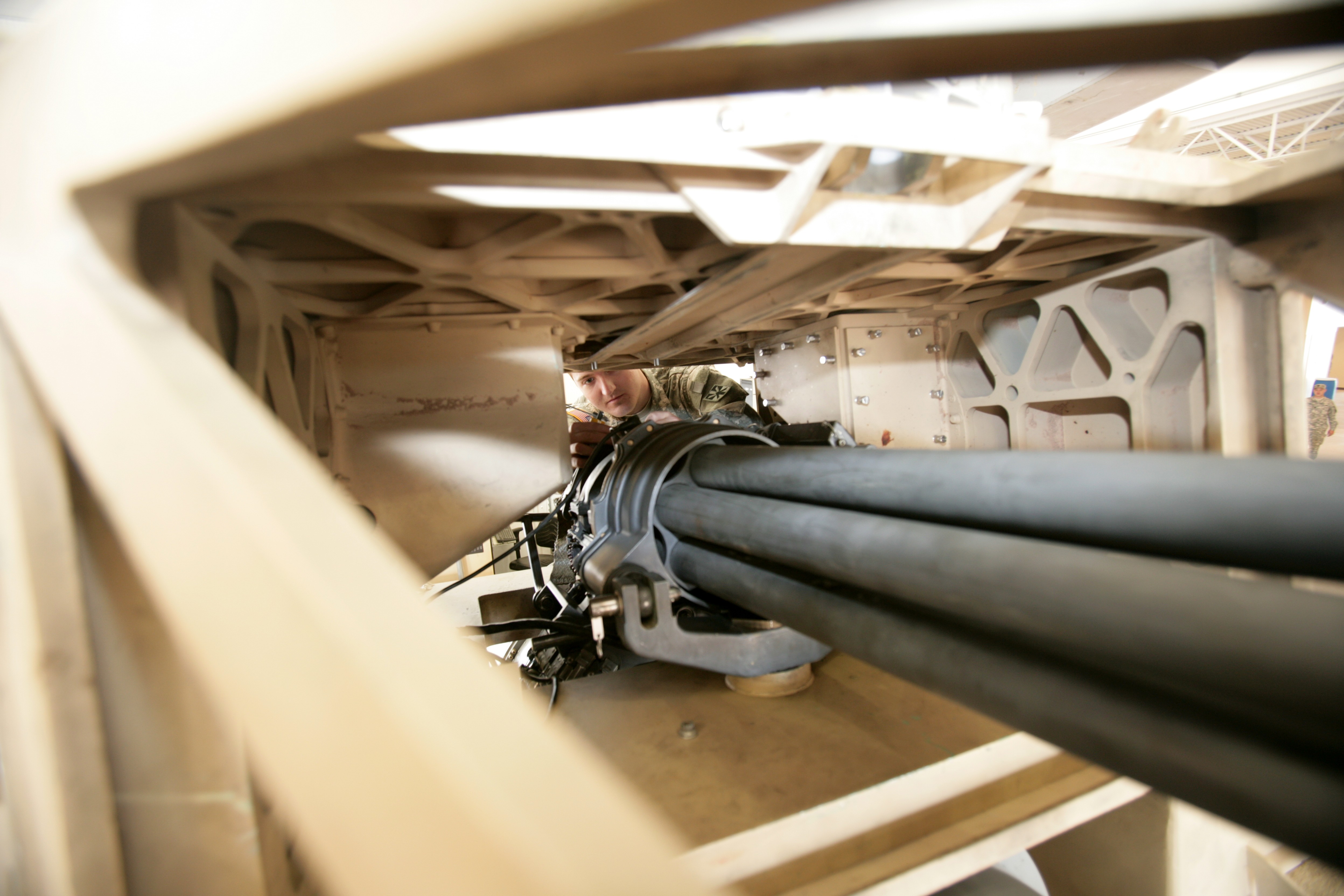As Staff Sgt. Kenneth Williams monitors the airspace from a radar monitor, Navy fire control technicians await his word to engage enemy "invaders" seeking to deliver death and destruction on their base. Given the approval to engage, they employ a weapon that packs a wallop destroying these invaders and saving Coalition lives.
For 10 weeks, Soldiers from D Battery, 2nd Battalion, 6th Brigade, Air Defense Artillery and civilian contractors have been training the first class of sailors to operate and maintain the Land-based Phalanx Weapons System, better known as LPWS. The precision-guided, rapid-fire, six-barrel gun includes radar systems that find and track enemy ordnance. It boasts a record that shows there's not enough room on Iraq bases for it and incoming enemy mortars and rockets.
<t$>Capt. John Williams, battery commander, leads the team of instructors whose sole purpose is to build the sailor confidence and understanding of the LPWS.
"Almost everyone who's teaching this course, whether Soldier or contractor, has deployed with the LPWS and seen it respond to a threat. They are here to ensure the sailors we are training are better prepared than we were."
First Lt. Rudy Mejia, battery executive officer, said the Army tried a different route when first employing the gun four years ago.
<t-6>"When the Army adopted the weapon from the Navy in 2005, they sent Soldiers to Navy bases to learn how to operate and maintain the guns. We found out that didn't work as well, and it was more effective and efficient to use sailors, who are already very familiar with the gun's operation and maintenance."
With the change, Soldiers now man the engagement operations cell, which oversees the battlespace, while sailors operate and maintain the guns. Though well-trained on the Phalanx Close-In Weapon System, the name the Navy calls the LPWS, the sailors' training at Fort Sill took further steps such as taking the gun apart and moving it to a new location. The sailors also learned how to engage and track targets at the gun, something the Navy doesn't do.
Range restrictions prevented the LPWS from functioning as it would in theater. Here, the two guns were restricted to fire into confined spaces to ensure the safety of Soldiers on adjacent training areas. Williams reminded the sailors the gun only fires on mortars or rockets in the threat zone.
He said shooting mortars is like learning to hit a slowly pitched baseball. Once the sailors got that process down, the training moved up to fast pitch rockets.
"Sailors will gain confidence in this gun realizing if a target is in the box the radar will lock on, and if approved to fire, the gun will shoot the mortar or rocket out of the sky."
Petty Officer 2nd Class Justin Anthony witnessed the lethality of the gun during his training as a weapon systems operator. Although the EOC gives LPWS operators the approval to fire, the operators provide the last sets of eyes to ensure intended targets aren't Coalition aircraft. When Anthony employed the gun, it quickly obliterated an incoming-mortar round.
Like many of his fellow sailors, Fire Control Technician 2nd Class Joshua Murray volunteered for the joint deployment. Murray said he's never used the gun in a wartime situation. He comes to the Army having served on a frigate with a crew of less than 200 sailors.
"I'm looking forward to getting in-country and seeing what this gun can do when called upon. I believe it will give me a sense of pride and that I'll be able to say I was there and did my time."
Regarding the training at Fort Sill, Murray called it an eye-opening experience.
"We've received more in-depth training here, and I've gained a greater understanding of the weapons system. I definitely know more now than when I left the ship, because the people who teach us are subject matter experts, they've been to Iraq and know what to expect."
The course also helped sailors and Soldiers learn how to communicate and work together as a team. Even so, humor popped up from time to time suggesting back to when inter-service rivalries were more pronounced. Several of the sailors volunteered for the training and deployment in what the Navy calls GSA positions. Although the acronym has an official meaning, the sailors joked it stood for, "Go save the Army." Murray added sailors got a chuckle from Soldiers ready to salute the eagle insignia ranks on the enlisted sailors' uniforms.
Still, the sailors learned to fit into Army life, to communicate on the radio as Soldiers do and to decode the plethora of different acronyms Soldiers speak.
Unlike other sailors who have experience with the Navy's version of the gun, Petty Officer 1st Class Eric Treece came to the weapons system from a completely different environment.
Previously, Treece kept his head below water as a mine counter measure specialist on an 85-90-man mine sweeper. With 16 years in service including more than nine years at sea, Treece wanted to find out what the land lubbers were all about.
"This is a good career decision, and I know having served in the Global War on Terrorism will look real good on my record," he said.
Staff Sgt. Raffael Donaldson is one of the course instructors who spent time in Iraq. Like many Soldiers he's experienced the trauma a randomly fired mortar can inflict on a base. He's witnessed the resulting casualties and destruction, but, since the LPWS was employed, Donaldson experienced a whole new aspect of life on a forward operating base.
"I was in-country seven months when I saw it take out a mortar. I was walking back from the PX and saw the smoke after the mortar was shot out of the sky.
"I know it works. Now, it's a relief to walk around the FOB knowing there's something that can take out mortars instead of just warning you they're coming in. This weapon system is a tremendous addition toward ensuring the safety and security within the FOB."
Murray spoke of a training scenario requiring the sailors to disassemble a gun, move it to a new location and assemble according to technical specifications. Speaking in a tone that suggested a sailor confident in his new mission and ready to put his training to work, Murray said, "We nailed our first target and that affirmed we did everything correctly and knew our jobs."


Social Sharing